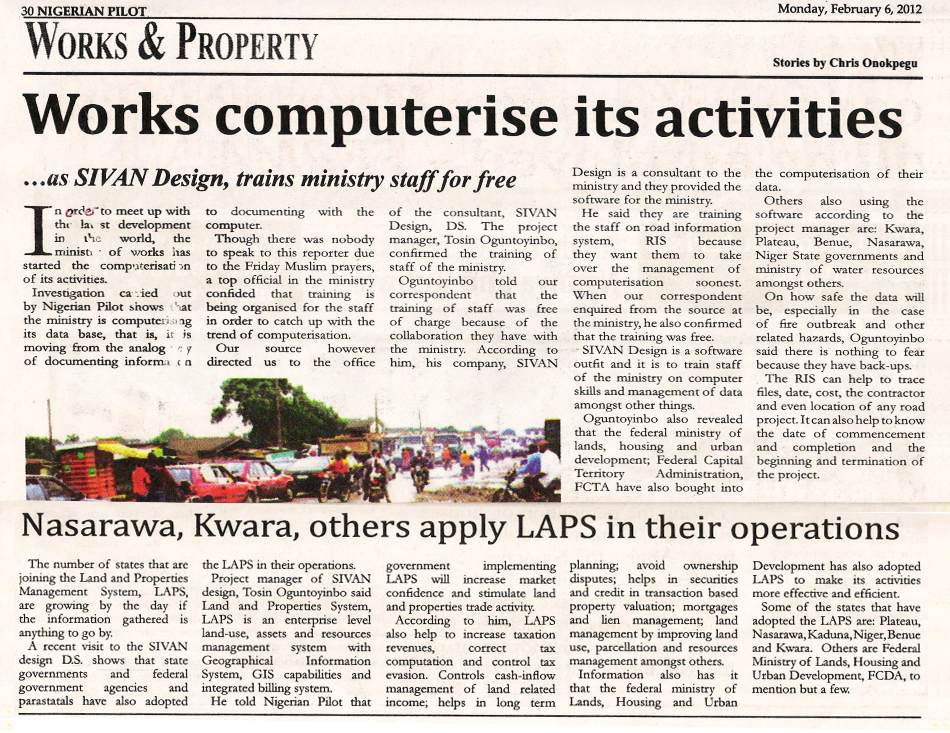LAPS – Land and Property Information System

Based on GeoERP technology, LAPS (Land and Property System) is Sivan Design’s enterprise level land-use, assets and resources management system with GIS capabilities. With a powerful set of tools, the system enables the user to store data, and analyze and print any desired information easily. LAPS stores all Land and Land-related data, including Ownerships, Title documents (CofO) and subsequent transactions (Deeds of Sub-lease, Deeds of Assignment…). The system also handles all financial aspects such as demand notice, receipt, valuation module etc. The GIS engine of the LAPS system stores all Cadastral layers (plots, blocks, layouts), their Geo-spatial information and the linkage to all title documents’ information.
Sivan Design specializes in analyzing the customer’s needs, adjusting the LAPS system to suit these needs, and complete integration of the software in the customer’s daily activity. Once implemented, the system can be used by government and local authorities to increase revenues by improving planning and collection of land and property taxes.
LAPS is used by government as well as federal and state authorities for the recording, registration and taxation of land properties. The system covers the whole land area of a country, allowing a government to efficiently plan and collect taxes from all land and property owners. This increased efficiency invariably leads to increased tax revenues as a result of more efficient tax collection. LAPS achieves these goals by using advanced and sophisticated software tools, computer technology and networking.
GeoERP Screen Shot – Land Management in action
Flexible and Robust Software “Engine”
The system is based on a software engine that was developed to accommodate the needs of every customer. Each project is based on this software engine and can be customized to the inpidual requirements of each government or costumer. The LAPS system offers sophisticated query and display capabilities. Maps of relevant areas are shown, with features of interest highlighted. The graphic and alphanumeric displays function in an integrated manner. This means that information selected in the alphanumeric window is automatically updated in the graphical window.
Using the LAPS graphically represented map display, all “gaps” in the land registration can be detected. These “gaps” are simply seen on the screen, and corrective action can be initiated.
Income Generation with LAPS
Governments can maximize revenues from their citizens and increase revenues to the state, local or federal authorities by calculating the correct property taxes and controlling tax evasion. To achieve this goal, Sivan’s software offers the following advantages:
- Ability to plan in advance land and property tax revenue. For the first time, a government is able to plan the cash flow related to land properties in advance.
- Advanced planning of land tax revenues: LAPS provides a first class tool for advanced planning and modifying of cash flow as a result of tax parameters on land properties.
- Reducing disputes over land and property ownership.
- Stimulation of land and property markets.
- Security for credit and loan approval.
- Improving management of state lands and properties.
In general, the implementation of LAPS boosts the country’s economy.
A government implementing LAPS will increase its revenues from the following sources:
- Annual tax payments from land and property owners.
- Lands and properties transactions.
- Queries by citizens.
- Mortgages and liens management.
Increased Tax Revenues
LAPS provides extensive help for tax collection. All taxes paid are centrally registered to prevent tax loss. LAPS is very useful when planning tax revenues. The system calculates the estimated revenue due to tax rate changes. This feature enables the government to plan future investments in relation to the property and the population. LAPS performs system analysis and design to determine the requirements of the individual application. Once the requirements have been determined, LAPS performs implementation, networking, maintenance and, if required, management of LAPS system. The LAPS system can be implemented gradually according to the available budgets.


